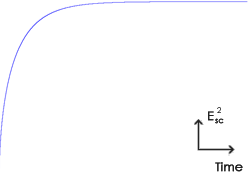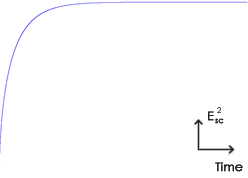Transport (continued)




















Charge carrier drift velocity is typically described in terms of charge carrier mobility μ, which is carrier velocity per unit electric field. In the disorder formalism, mobility is given by:P. M. Borsenberger and D. S. Weiss, "Organic photoreceptors for xerography" (Marcel Dekker: New York, 1998)

where C is a constant, kB is the Boltzmann constant, E is the electric field, T is the temperature, σ is the parameter that characterizes DOS distribution (and diagonal, or energetic, disorder), and Σ is a parameter that characterizes off-diagonal, or positional, disorder.
Use the slider on the right to see how the dynamics of formation of the space-charge field changes with values of μ (charge carrier mobility) from 10-8 cm2/(Vs) to 10-6 cm2/(Vs) (typical for photorefractive polymer composites). As the mobility μ increases, the space-charge field Esc forms faster.O. Ostroverkhova and K. D. Singer, J. Appl. Phys. 92, 1727 (2002) The reason Esc2, and not Esc, is plotted as a function of time on the figure is because diffraction efficiency measured in Four-Wave-Mixing experiments at low applied electric fields E0 is proportional to Esc2 and therefore, dynamics of Esc2 can be directly related to that of experimentally measured diffraction efficiency.